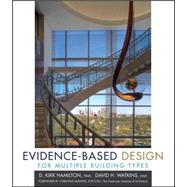
Evidence-Based Design for Multiple Building Types
by Hamilton, D. Kirk; Watkins, David H.Buy New
Buy Used
Rent Textbook
eTextbook
We're Sorry
Not Available
How Marketplace Works:
- This item is offered by an independent seller and not shipped from our warehouse
- Item details like edition and cover design may differ from our description; see seller's comments before ordering.
- Sellers much confirm and ship within two business days; otherwise, the order will be cancelled and refunded.
- Marketplace purchases cannot be returned to eCampus.com. Contact the seller directly for inquiries; if no response within two days, contact customer service.
- Additional shipping costs apply to Marketplace purchases. Review shipping costs at checkout.
Summary
Author Biography
D. Kirk Hamilton, FAIA, FACHA, is associate director of the Center for Health Systems & Design and associate professor of architecture at Texas A&M University. His research focuses on the relationship between evidence-based design of health facilities and measurable organizational perform-ance. A founding principal emeritus of WHR Architects, Hamilton is a board-certified healthcare architect with thirty years' experience in hospital design. Currently on the board of The Center for Health Design, Hamilton has served as president of both the AIA Academy of Architecture for Health and the American College of Healthcare Architects.
David H. Watkins, FAIA, is chair-man and founding principal of WHR Architects in Houston, a nationally recognized firm specializing in high- performance buildings for healthcare, science, and higher education. A longtime advocate for advancing the knowledge resources available to the profession of architecture, Watkins served as a vice president of the American Institute of Architects (AIA) and inaugural chair of the AIA board's knowledge committee in 2004. He serves on the advisory boards for the architectural programs at Rice University and The University of Texas at Austin, and from 2005 to 2007, he was a director of the National Architectural Accrediting Board.
Table of Contents
| Foreward By Chris McEntee | |
| Acknowledgements | |
| Introduction | |
| The Case for Evidence-Based Design | |
| What is Evidence-Based Design? | |
| Precedent-Based Professions & Transforming Architecture | |
| The New Practitioner | |
| Sustainable Design is Founded on Evidence | |
| Evidence-Based Design for Building Types | |
| Evidence-Based Medicine and Healthcare Design | |
| Evidence in the Design of Learning Environments | |
| Evidence and Data in the Design of Workplace Environments | |
| Data Drives the Design of Retail Environments | |
| Evidence-Based Environments for Science | |
| Evidence in Places for Assembly and Performance | |
| Evidence in Historic Preservation & Adaptive Reuse | |
| Evidence in Urban Planning | |
| Designing With Evidence | |
| Process & Methods for Evidence-Based Design | |
| Evidence Sources & Limitations | |
| The Practitioner as Researcher | |
| The Challenges for Architectural Education | |
| Conclusion: Architecture will always be Knowledge-Based | |
| Bibliography | |
| Index | |
| Table of Contents provided by Publisher. All Rights Reserved. |
An electronic version of this book is available through VitalSource.
This book is viewable on PC, Mac, iPhone, iPad, iPod Touch, and most smartphones.
By purchasing, you will be able to view this book online, as well as download it, for the chosen number of days.
Digital License
You are licensing a digital product for a set duration. Durations are set forth in the product description, with "Lifetime" typically meaning five (5) years of online access and permanent download to a supported device. All licenses are non-transferable.
More details can be found here.
A downloadable version of this book is available through the eCampus Reader or compatible Adobe readers.
Applications are available on iOS, Android, PC, Mac, and Windows Mobile platforms.
Please view the compatibility matrix prior to purchase.
